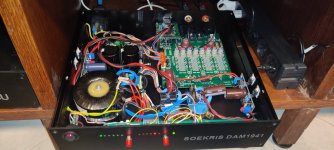yes, not suitable for this case. It is also exists thread for "Salas low voltage shunt regulator" https://www.diyaudio.com/community/threads/the-simplistic-salas-low-voltage-shunt-regulator.143693/ . In sum: what you suggested for powering chips or R2R dac boards with such low voltage? May be it is important shunt with low impedance on wide range of frequencies.No, not that low. Not below +/-5 that is.
yes, not suitable for this case. It is also exists thread for "Salas low voltage shunt regulator" https://www.diyaudio.com/community/threads/the-simplistic-salas-low-voltage-shunt-regulator.143693/ . In sum: what you suggested for powering chips or R2R dac boards with such low voltage? May be it is important shunt with low impedance on wide range of frequencies.
I used Salas refektor for lower voltages on mine.
About 1.5V only L-Adapter can reach so low. Or you use 3.3V Reflektor as pre-reg and you continue with your favorite 1.2V LDO chip reg.
Thank you for suggestion! So best power could be:About 1.5V only L-Adapter can reach so low. Or you use 3.3V Reflektor as pre-reg and you continue with your favorite 1.2V LDO chip reg.
1.2V = Reflektor-D -> LT3045 (for pcs in parallel)
3.3V = Reflektor-D
+-5V and more = UltraBib1.3 (is it better then Reflektor-D?)
Good choice?
Also easier to arrange in a crowded box (if to sink on surfaces off-board) is Reflektor Mini edition + Fllexy companion raw supply.
Left side sink mounted board. Looks like a Reflektor Mini with perfboard raw psu. Nice clean DAC arrangement work by the way. Congrats.I used Salas refektor for lower voltages on mine.
May be. Plus before this may be will be good idea to use LT1963 with filters, as variant from AIYIMA:Also easier to arrange in a crowded box (if to sink on surfaces off-board) is Reflektor Mini edition + Fllexy companion raw supply.
https://aliexpress.com/item/1005002662883179.html
So don't needed DC bridge.
Do you trust those three LT1963 are originals at such low price? Including board, ELNA ;-) caps, etc? 6.65 Euro just one chip on Digikey.
this is simply for example 🙂Do you trust those three LT1963 are originals at such low price? Including board, ELNA ;-) caps, etc? 6.65 Euro just one chip on Digikey.
I now even have a second reflektor for a second usb port I have attached on the i2s port of the board.Left side sink mounted board. Looks like a Reflektor Mini with perfboard raw psu. Nice clean DAC arrangement work by the way. Congrats.
Attachments
you use Reflektor-D for digits lines and UltraBib1.3 for analogs lines?I now even have a second reflektor for a second usb port I have attached on the i2s port of the board.
Correctyou use Reflektor-D for digits lines and UltraBib1.3 for analogs lines
Salas one more question: is it good idea instead of own DC rectification in UltraBib1.3, Reflektor-D to use rectification based on LT1963 or may be on LT1117? Or it is better to use pure DC bridge without any LDOs?
Those are reg chips so its flat DC not raw DC they provide. Essentially you plan them as pre-regs.
No problem with the concept unless there's chance of some bad interaction with the CCSed shunt after-regs loaded. Oscillations we can't predict.
The pre-regs have feedback they are active. Objectively the rail lines in such a system should be checking calm on the oscilloscope.
Subjectively its interesting to try either (raw dc vs pre-reg dc) on one and decide. To see if less is more in this case.
No problem with the concept unless there's chance of some bad interaction with the CCSed shunt after-regs loaded. Oscillations we can't predict.
The pre-regs have feedback they are active. Objectively the rail lines in such a system should be checking calm on the oscilloscope.
Subjectively its interesting to try either (raw dc vs pre-reg dc) on one and decide. To see if less is more in this case.
Why I ask - Andrea Ciuffoli likes to use LDOs before shunt with low impedance http://www.audiodesignguide.com/DAC32/index2.html, LT1963. In next DAC he used LT1117 http://www.audiodesignguide.com/DACES9038PRO/index.html. His ES9018 DAC sounds marvelous.
Perhaps LDOs is not bad. Let's think positive and there are no oscillations issues. Maybe LDOs will do good job: stabalize DC power in rude way, but shunt regs after them will do it more precise, more accurate and LDOs will help because there will be not big gasp in voltage during power consumtion and then it will be easier work for shunt.
Then the question is which LDOs is best: more fast or more precise.
Perhaps LDOs is not bad. Let's think positive and there are no oscillations issues. Maybe LDOs will do good job: stabalize DC power in rude way, but shunt regs after them will do it more precise, more accurate and LDOs will help because there will be not big gasp in voltage during power consumtion and then it will be easier work for shunt.
Then the question is which LDOs is best: more fast or more precise.
Last edited:
Was the same question
https://www.diyaudio.com/community/threads/reflektor-d-builds.261031/post-5551615
And as you answered - all must be tested.
https://www.diyaudio.com/community/threads/reflektor-d-builds.261031/post-5551615
And as you answered - all must be tested.
- Home
- Amplifiers
- Power Supplies
- Salas SSLV1.3 UltraBiB shunt regulator
